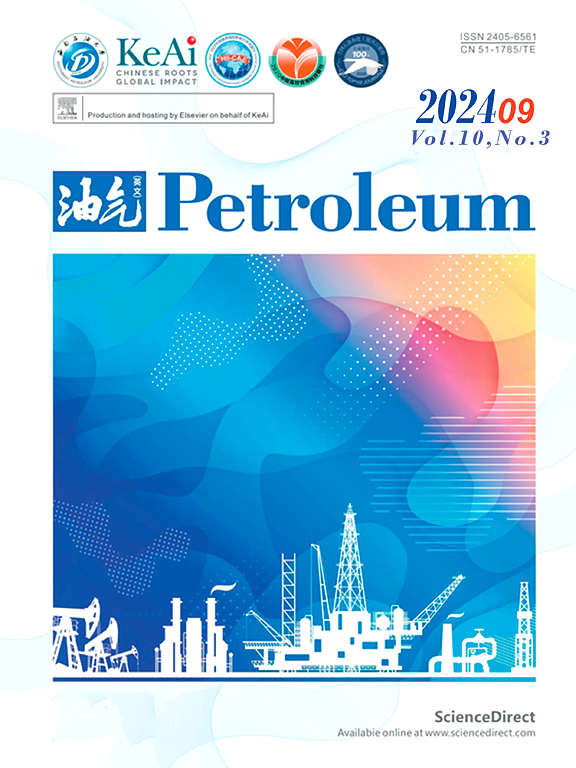基于密闭空间黏度变化和界面滑移特征的致密储层纳米流动模型建模与分析
IF 3.5
Q2 ENERGY & FUELS
引用次数: 0
摘要
了解纳米孔隙中油气与界面之间的流动机制对大储量致密储层的流体供应至关重要。本文基于分子界面理论分析了纳米级液固界面相互作用势,通过Eyring模型构建了新的纳米级流体粘度模型,并基于液固界面滑移条件推导了纳米孔内流体速度和流量模型。此外,研究了正戊烷在石英纳米孔中的流动特性,主要参数包括:Hamaker常数、衰减长度、润湿角、边界滑移和通量系数。通过理论、仿真和实验结果的比较,验证了该模型的有效性。研究结果表明:(1)受液固界面效应的影响,体内流体与边界处存在粘度间隙,导致流速呈非线性变化。在模型考虑的多种微观力中,在40 nm以下的密闭孔隙中,利希茨-范德华力的作用最强,静电力的作用最弱。当孔径小于10 nm时,约束流体粘度提高了4倍以上。(2)基于微观液固界面滑移条件,推导了约束空间速度模型,该模型表明流动直接取决于流体的有效剪切应力和液固界面效应的强度。致密储层在低剪应力条件下,液固界面滑移具有明显的线性特征,且滑移速度与有效剪应力有关。液固界面效应参数从1增加到30,滑移速度降低到3.2 Å/ps,降低了55%。(3)得到了基于分子间距变化的正戊烷-石英界面hamaker常数以及不同水类型和溶质浓度下的衰减常数,并探讨了不同孔隙半径下衰减长度对纳米密闭流动模型流动系数的影响。通量系数随孔隙半径的增大而增大,当孔隙为100 nm时,衰减长度的影响更大。本文章由计算机程序翻译,如有差异,请以英文原文为准。
Nanoscale flow model modelling and analysis of tight reservoir based on viscosity change and interfacial slip characteristics in confined space
Understanding the flow mechanisms between hydrocarbons and interfaces in nanopores is critical for fluid supply in tight reservoirs with huge reserves. In this paper, the nanoscale liquid-solid interface interaction potential is analyzed based on the molecular interface theory, and a new nanoscale fluid viscosity model is constructed through the Eyring model, and the fluid velocity and flow flux models in nanopores are derived based on the liquid-solid interface slip condition. In addition, n-pentane flow characteristics in quartz nanopores were investigated with key parameters including: the Hamaker constant, the decay length, the wetting angle, the boundary slip and the flux coefficient. The proposed model is validated in a comparison of theory, simulation and laboratory results. The study results show: (1) influenced by the liquid-solid interfacial effect, there is a viscosity gap between the fluid in the bulk and at the boundary, resulting in a non-linear variation of the flow velocity. Of the multiple microscopic forces considered by the model, Ligshitz-Van der Waals force has the strongest effect in confined pores below 40 nm, and electrostatic force has the weakest effect. When the pore diameter less than 10 nm, the constrained fluid viscosity was improved above 4 times. (2) based on the microscopic liquid-solid interface slip condition, a constrained space velocity model is derived, which indicates that the flow is directly dependent on the effective shear stresses on the fluid and the strength of the liquid-solid interface effect. Under the low shear stress in a tight reservoir, the slip at the liquid-solid interface has obvious linear characteristics, and the slip velocity depends on the effective shear stress. The liquid-solid interfacial effect parameter is increased from 1 to 30, and the slip velocity is reduced to 3.2 Å/ps, which is a 55% reduction. (3) in this paper, the hamaker constant of n-pentane-quartz interface based on the molecular spacing variation and the decay constant for different water types and solute concentrations are obtained, and the effect of the decay length on the flow coefficient of the nano confined flow model is explored for different pore radiuses. The flux coefficient increases with pore radius, and the effect of the decay length is greater for pores <100 nm.
求助全文
通过发布文献求助,成功后即可免费获取论文全文。
去求助
来源期刊

Petroleum
Earth and Planetary Sciences-Geology
CiteScore
9.20
自引率
0.00%
发文量
76
审稿时长
124 days
期刊介绍:
Examples of appropriate topical areas that will be considered include the following: 1.comprehensive research on oil and gas reservoir (reservoir geology): -geological basis of oil and gas reservoirs -reservoir geochemistry -reservoir formation mechanism -reservoir identification methods and techniques 2.kinetics of oil and gas basins and analyses of potential oil and gas resources: -fine description factors of hydrocarbon accumulation -mechanism analysis on recovery and dynamic accumulation process -relationship between accumulation factors and the accumulation process -analysis of oil and gas potential resource 3.theories and methods for complex reservoir geophysical prospecting: -geophysical basis of deep geologic structures and background of hydrocarbon occurrence -geophysical prediction of deep and complex reservoirs -physical test analyses and numerical simulations of reservoir rocks -anisotropic medium seismic imaging theory and new technology for multiwave seismic exploration -o theories and methods for reservoir fluid geophysical identification and prediction 4.theories, methods, technology, and design for complex reservoir development: -reservoir percolation theory and application technology -field development theories and methods -theory and technology for enhancing recovery efficiency 5.working liquid for oil and gas wells and reservoir protection technology: -working chemicals and mechanics for oil and gas wells -reservoir protection technology 6.new techniques and technologies for oil and gas drilling and production: -under-balanced drilling/gas drilling -special-track well drilling -cementing and completion of oil and gas wells -engineering safety applications for oil and gas wells -new technology of fracture acidizing
 求助内容:
求助内容: 应助结果提醒方式:
应助结果提醒方式:


